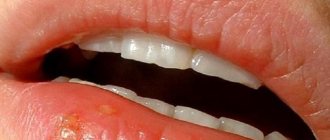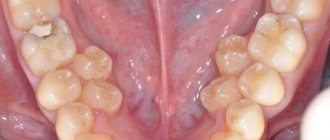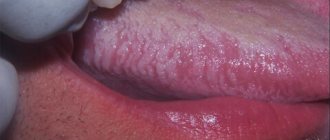How is herpes transmitted to children?
The herpes virus is very common and lives in almost all living things. It is transmitted by airborne droplets and contact . Once the herpes virus enters the body, it remains there for life. However, it can be in a “sleeping” state and not bother a person. If the herpes virus in a child has made itself felt, parents need to pay attention to this problem, because some herpes infections can take forms that are dangerous to health.
Children become infected with the herpes virus more often than adults, but overprotecting a child from infection is pointless and harmful. immunity to it . But the body is safe only in a situation where the infection is easy and without complications.
Enteroviral stomatitis
Enteroviral stomatitis (hand-foot-mouth syndrome) is also characterized by the formation of painful aphthae on the tongue, under the tongue, on the mucous membranes of the cheeks and lips, on the soft palate and at the base of the gums. Accompanied by a blistering rash around the mouth, on the palms, back of the hands, feet, back of the thighs and buttocks of the child, fever, sore throat, headache, loss of appetite.
The causative agents of enteroviral stomatitis are the Coxsackie virus and other enteroviruses. The disease is very common among young children in the summer and is transmitted through contact with an infected person through the airborne or fecal-oral route: through dishes, hygiene items, bedding, toys.
The incubation period (from infection to the onset of symptoms) is 3 to 6 days. Fever is often the first sign of illness. Painful aphthae in the mouth appear 1–2 days after the onset of fever, then rashes are observed on the arms, legs and buttocks. Enteroviral stomatitis does not require special treatment, all signs and symptoms of the disease usually disappear after a week, and the child’s condition returns to normal.
Types of disease in children
There are 80 types of herpes virus, of which 8 are dangerous to humans. The nature of the disease and the type of herpetic rash depend on the type of herpes simplex virus (HSV):
- Type 1 HSV - looks like cold-like rashes in the form of blisters on the lips, causes herpetic stomatitis and herpetic encephalitis.
- Type 2 HSV – manifests itself as a rash on the genitals (genital herpes).
- Type 3 HSV – causes chickenpox and recurrent herpes zoster.
- The 4th type of HSV - Epshane-Barr virus, causes malignant lymphoma and infectious mononucleosis - an acute viral disease with fever, damage to the respiratory tract, lymph nodes, liver, spleen and blood.
- Type 5 HSV – cytomegalovirus; affects the respiratory system, internal organs, intestines, eyes, brain, nervous and urinary systems.
- Type 6 HSV - causes viral eczema - exanthema - pseudorubella-type rash;
- The 7th and 8th types of HSV have not been sufficiently studied. Source: A.G. Lateral Herpesvirus infections in children - an urgent problem of modern clinical practice // Children's infections, 2010, No. 2, pp. 3-7
Infectious mononucleosis
Another disease of viral etiology with severe “cold” symptoms. The main causative agent of infectious mononucleosis is the Epstein-Barr virus (rarely other viruses). The infection spreads through saliva.
The disease is typical for adolescents and young adults (the so-called “kissing disease”), but young children can also become infected with infectious mononucleosis through contact with objects touched by an infected person (for example, through dishes). Most adults already have antibodies to IM because they have been exposed to the infection, so they are immune and do not get sick. In people with a weakened immune system due to concomitant pathologies or organ transplantation, MI can cause serious complications and other diseases (anemia, meningitis, encephalitis, myocarditis, etc.).
Symptoms of MI appear approximately 4–6 weeks after infection and may develop slowly and not all at the same time. They include severe sore throat, weakness, fatigue, fever, loss of appetite, enlarged neck and axillary lymph nodes, inflammation of the tonsils with white plaque, headache, muscle pain, skin rashes, abdominal pain, enlarged spleen or liver.
Most patients recover within 2–4 weeks of onset of symptoms, but some continue to experience symptoms of MI (eg, fatigue, enlarged lymph nodes, splenomegaly, hepatomegaly) for several weeks or even months.
The disease is diagnosed based on symptoms, their duration and specificity, as well as a physical examination. A blood test for antibodies to the Epstein-Barr virus and a general blood test to determine the level of leukocytes (prescribed if necessary) help confirm the diagnosis.
The symptoms of MI are quite unpleasant and cause significant discomfort to the patient, but the disease goes away on its own, without treatment or any consequences. Drinking plenty of fluids, rest and a healthy diet are recommended. To relieve symptoms (sore throat, headache, muscle pain, fever), it is recommended to use paracetamol or ibuprofen, or gargle with salt water. The addition of a secondary infection (streptococcal, for example) requires the use of antibacterial drugs. If the airways are severely narrowed and there is difficulty breathing, corticosteroids may be prescribed. To reduce the risk of rupture of the capsule of an enlarged spleen or liver, it is recommended to avoid exercise, heavy lifting, and contact sports for at least a month, or until the liver and spleen return to normal size.
Virus activity
Most often, children are faced with the herpes simplex virus, which manifests itself in the form of that same cold on the lips.
Herpes on the lips or chickenpox are not as dangerous for a child as herpetic lesions of the eyes, genitals, and internal organs.
Externally, herpes appears as a rash on the skin or mucous membranes. It usually looks like small blisters that eventually burst and become sores. In addition to the rash, there is burning and itching.
How often the herpes virus is activated is influenced by hereditary predisposition and the state of the immune system. The weaker the child’s immunity, the more susceptible he is to virus attacks.
Newborns up to 1 year of age are protected by maternal antibodies. The peak incidence is observed at the age of 2-3 years. By the age of 15, up to 90% of adolescents are infected with HSV. The pathogen is in an inactive state in the body and does not cause discomfort. Under unfavorable conditions, HSV is activated. Source: A. Taieb, N. Diris, F. Boralevu, C. Labreze Herpes simplex in children. Clinical manifestations, diagnostic value of clinical signs, clinical course // Ann Dermatol Venerol, 2002, v.129, No. 4, p.603—608
Causes of exacerbations and relapses of herpes in children:
- decreased immunity due to severe and prolonged illnesses;
- severe shocks and chronic stress;
- systematic fatigue;
- hypothermia;
- taking hormonal medications;
- endocrine pathologies;
- hormonal changes in adolescence;
- systematic unbalanced diet;
- complicated seasonal colds;
- chemical and radiation anticancer therapy;
- excessive physical activity. Source: M.N. Kankasova, O.G. Mokhova, O.S. Pozdeeva Frequently ill children: the view of an infectious disease specialist // Practical Medicine, 2014, No. 9(85), pp. 67-71
Newborn herpes
20.09.2012 26679
A very unpleasant and dangerous disease!
Herpetic infection is the most common human viral infection, existing in the body mainly in a latent form and manifested against the background of immunodeficiency states by lesions of the skin, mucous membranes, eyes, liver and central nervous system. It is the most commonly diagnosed infection among congenital and neonatal diseases. Relevance. Infection of the adult population with herpes simplex viruses reaches 90-95%. In recent years, there has been an increase in the number of cases of herpes infection in newborns all over the world. The mortality rate from neonatal herpes reaches 50-70%. Only 15% remain healthy; many children subsequently suffer from severe neurological diseases.
Etiology. The herpes simplex virus is part of the herpes virus family, divided into herpes simplex virus type 1 - labial and herpes simplex virus type 2 - genital. Genital herpes is the most dangerous for the fetus.
The herpes simplex virus consists of three main components: a nucleotide, a capsid, and a lipid-containing envelope. The genome is represented by linear double-stranded DNA.
Epidemiology. The natural host of the herpes simplex virus is humans. Ways of transmission of infection:
- airborne;
— sexual (is the main one for herpes simplex virus type 2);
- contact (when the fetus passes through the mother's birth canal during childbirth, the infection rate is 40-50%, morbidity - 20%, mortality - 40%);
-vertical (the risk of transmission during a primary infection in a pregnant woman is 50%, with the first clinical manifestation of a non-primary infection - up to 33%, with a recurrence of herpetic infection - up to 3%);
- transplacental.
Most often, the disease is transmitted to the fetus during childbirth from the mother, who has an infected birth canal and often has a chronic urinary tract infection. The entrance gates can be injured skin, mucous membranes of the lips, mouth, nose, conjunctiva and genitals. Vertical transmission of infection from mother to fetus can occur through damaged and even intact placenta. Infection is accompanied by viral replication at the site of invasion. Further, it is able to spread neurogenically, lympho- and hematogenously. The favorite localization is the sensory ganglia, where the infection can persist for a long time.
Clinical picture. Symptoms Manifestations of congenital herpes infection depend on the timing of infection. A reliable connection has been established between herpes infection and malformations of the gastrointestinal tract, heart, genitourinary system, skeleton, and congenital cicatricial deformities of the skin. The herpes virus can cause organic damage to the central nervous system (micro- and hydrocephalus, cerebral palsy, epilepsy), liver cirrhosis, neonatal hepatitis, severe damage to the eyes, lungs, skin and mucous membranes. The incubation period ranges from 2 to 30 days. There are 3 clinical forms of herpes infection in newborns:
1) Localized form with damage to the skin and mucous membranes of the mouth, eyes - occurs in 20-40% of patients. It is characterized by the presence of single or multiple vesicular elements in various parts of the body in the absence of signs of a systemic inflammatory reaction. Bubbles measuring 1.5-2 mm against a background of erythema and edema. Most often they appear on days 5-14 of life. When they are opened, erosions with a smooth bottom are formed. There may be unstable pigmentation at the site of erosion; the healing process lasts approximately 10-14 days. The development of herpetic keratoconjunctivitis, chorioretinitis, corneal erosions, uveitis, episcleritis or iridocyclitis is possible. In some cases, specific optic neuritis is observed. In the absence of specific treatment, in 50-70% of newborns, the localized cutaneous form can lead to generalization of the process or damage to the central nervous system.
2) The generalized form accounts for 20 to 50% of cases of neonatal herpes. The onset of the disease is most often on the 5-11th day of life, but an earlier manifestation is possible in the first 24-48 hours of life. Clinical symptoms are nonspecific and resemble neonatal sepsis: lethargy, regurgitation, increase or decrease in body temperature, severe microcirculation disturbance, apnea, cyanosis, shortness of breath, and sometimes signs of pneumonia. Characteristic is the involvement of the liver and adrenal glands in the pathological process. An enlarged spleen, hypoglycemia, hyperbilirubinemia, disseminated intravascular coagulation syndrome, and signs of infectious-toxic shock are observed. 50-60% of patients experience symptoms of herpetic meningoencephalitis. Specific rashes on the skin and mucous membranes appear on days 2-8 from the onset of the disease, however, in 20% of newborns with a generalized form of HI, no skin elements are found.
3) Herpetic lesions of the central nervous system (encephalitis, meningoencephalitis) account for about 30% of cases. The development of clinical symptoms of the disease in most cases is observed in the 2-3rd week of life (12-17th days of life). The disease begins with a rise in body temperature, lethargy, alternating with episodes of increased excitability, tremor, decreased appetite, followed by the rapid development of poorly controlled focal or generalized convulsions. At first, the cerebrospinal fluid may not be changed, then an increase in protein content and cytosis of a lymphocytic or mixed nature are detected. 40-60% of patients do not have specific herpetic eruptions on the skin and mucous membranes. With antenatal infection, the birth of children with microcephaly, hydrocephalus, and the presence of intracranial calcifications is possible.
Diagnosis of herpes infection:
• Of particular importance is the assessment of the mother’s specific medical history (chronic somatic pathology, cervical erosion, salpingoophoritis, colpitis, spontaneous abortions, non-developing pregnancy, antenatal fetal death, herpetic rashes on the skin and mucous membranes of the mother during this pregnancy).
• Clinical examination of the patient: in children born to mothers with acute or recurrent herpes infection, examination of the skin and mucous membranes must be carried out with special care in order to early identify herpetic elements.
• If a newborn has seizures of unknown etiology, a lumbar puncture is indicated. With herpetic meningoencephalitis, a high concentration of protein and lymphocytosis/monocytosis are observed in the cerebrospinal fluid.
• If clinical sepsis occurs in a newborn, in which it is not possible to achieve the effect of targeted antibacterial therapy, it is necessary to conduct laboratory tests for herpes infection.
• Additional clinical-laboratory and clinical-instrumental studies (clinical and biochemical tests of blood and urine, neurosonography, computed tomography of the brain, if indicated - EEG, coagulogram, computed tomography, chest x-ray) allow us to assess the condition of individual organs, systems and the degree their involvement in the pathological process.
• Herpetic etiology of the disease must be confirmed by special laboratory methods:
— the “gold standard” is the isolation of the virus from blood, cerebrospinal fluid, vesicle contents and other loci (nasopharynx, conjunctiva) in tissue culture (sensitivity up to 100%, specificity 100%, analysis duration of at least 5 days);
— electron microscopy;
- cytological diagnostics, based on microscopic examination of tissue preparations stained using the Wright-Giemsa, Papanicolaou method;
— the contents of the vesicles can be examined using a direct immunofluorescent method to detect the herpes simplex virus antigen;
— detection of the virus genome in blood and cerebrospinal fluid using the polymerase chain reaction method (sensitivity of the method - 95%, specificity - 90-100%, analysis time - 1-2 days);
- detection of specific IgG and IgM antibodies to HSV by ELISA in the blood, cerebrospinal fluid (which is of great importance for the diagnosis of this infection, the causative agent of which has an extremely pronounced tropism for the nervous system), urine, and nasopharyngeal contents. The method of “paired sera” taken for research with an interval of 10-14 days is of particular diagnostic value in newborns and infants. An increase in immunoglobulin titer by 4 or more times during this period confirms the diagnosis of herpes infection.
• Pathomorphology of the placenta. Macroscopically, the membranes of the placenta are yellowish and cloudy. Histological examination reveals basal deciduitis. Typical herpetic cells are large in size, with basophilic inclusions in the nucleus, surrounded by a rim of clearing. The cytoplasm of the cells is initially weakly basophilic, then strongly acidophilic. In all damaged villi, activation of fixed macrophages (Hoffbauer-Kashchenko cells) occurs. Hemorrhages, fibrin deposits and thrombus formation, multiple foci of necrosis and calcification are found in the basal lamina.
Treatment of herpes infection. For all forms of neonatal herpes infection, specific antiviral therapy is indicated, since the localized form may precede the generalization of the infection. In newborns with localized forms of the disease, acyclovir is used intravenously at a dose of 45 mg/kg/day; for a generalized form of infection and meningoencephalitis - at a dose of 60 mg/kg/day. Enteral administration of acyclovir in newborns may not be effective enough. Duration of treatment: localized form – 10-14 days; generalized form and meningoencephalitis - at least 21 days. For herpetic eye lesions, you can use a 1% solution of iododioxyuridine, a 3% solution of vidarabine, and a 1-2% solution of trifluridine. Damaged skin is treated with Acyclovir and Zavirax ointment 3 times a day.
Among herbal preparations that have a noticeable antiviral effect, derivatives of licorice and St. John's wort are most often used in the treatment of herpes infection. These products are used mainly locally. Thus, epigen, produced on the basis of glycyrrhizic acid salts, significantly reduces the healing time of mucocutaneous lesions.
In case of a generalized form of infection in conditions of an immunodeficiency state, polyspecific intravenous immunoglobulins (Octagam, Intraglobin, Sandoglobin, Pentaglobin) and immunoglobulins with a high titer of antibodies to the herpes simplex virus can be used in complex therapy of newborns, including premature infants. An integral part of the pathogenetic therapy of herpes infection is also the use of interferon-type drugs: Viferon-1 in suppositories (dose 150,000 IU once a day per rectum for 5 days). Maintaining the vital functions of a child’s body with a generalized form of neonatal herpes is carried out in accordance with the general principles of intensive care. An important place in the treatment of herpetic meningoencephalitis is occupied by adequate anticonvulsant therapy. It makes no sense to stop breastfeeding a child, since even with a primary infection in the mother, the penetration of HSV into milk is unlikely. The exception is when the mother has herpetic rashes located on the chest.
Prevention of herpes infection.
1) Identification of high-risk pregnant women:
a) a thorough history taking to identify episodes of genital herpes;
b) a thorough clinical examination of the birth canal, perineum and vulva during observation in antenatal clinics and before the onset of labor; c) virological confirmation of herpes-like genital lesions in all women planning pregnancy.
2) Management of pregnancy and childbirth should be based on clinical principles and anamnesis:
a) in women with a primary clinical episode of herpes infection less than 6 weeks before birth, a planned cesarean section is necessary;
b) if the episode occurred more than 6 weeks before birth, vaginal delivery is possible; to reduce the risk of exacerbation of the disease at the time of birth, it is advisable to use acyclovir from 36 weeks of pregnancy;
c) disseminated and severe primary maternal infection require treatment with acyclovir, regardless of the stage of pregnancy;
d) in the presence of genital herpes in the mother and natural birth, newborns are subject to examination and preventive therapy with acyclovir. If a negative laboratory test result for herpes infection is obtained and there are no clinical manifestations of the disease, antiviral therapy is stopped.
Outcomes of neonatal herpes infection. With early administration of antiviral therapy, mortality in generalized forms of infection is less than 50%, while in the absence of specific treatment it is 90%; with meningoencephalitis – 14%. The incidence of neurological complications ranges from 10 to 43%; recurrences of skin manifestations in the first 6 months of life are observed in 46% of children.
Treatment of herpes in children
It is impossible to eliminate the herpes virus from the body, so the goal of treatment is to reduce its activity , eliminate symptoms by activating the immune system, achieve stable remission and prevent complications.
The most effective medicine against most manifestations of the herpes virus in children is the substance acyclovir. Treatment uses both oral and local medications. Source: I.F. Barinsky, L.M. Alimbarova, A.A. Lazarenko, F.R. Makhmudov, O.V. Sergeev Vaccines as a means of specific immunocorrection for herpetic infections // Questions of Virology, 2014, pp. 5-11
A comprehensive treatment regimen for acute herpetic infection includes:
- antiviral-antiherpetic drugs - tablets, injections and ointments - based on acyclovir;
- surface antiseptics for the prevention of secondary bacterial infections;
- immune stimulants – herbal and interferon derivatives;
- multivitamins and vitamins in therapeutic doses;
- antipruritic antihistamines;
- antipyretics;
- hepatoprotectors – in case of severe intoxication;
- diet therapy with sufficient amounts of protein and exclusion of foods that are sources of arginine.
In severe general condition, bed rest is recommended. Only a doctor can decide how to treat herpes in a child.
Possible complications
Without timely and adequate treatment, herpes infection can cause severe complications:
- disruption of internal organs;
- eye diseases;
- deafness;
- sore throat;
- nervous and mental disorders;
- infertility.
Sources:
- A.G. Side. Herpesvirus infections in children - an urgent problem of modern clinical practice // Children's infections, 2010, No. 2, pp. 3-7.
- Taieb, N. Diris, F. Boralevu, C. Labreze. Herpes simplex in children. Clinical manifestations, diagnostic value of clinical signs, clinical course // Ann Dermatol Venerol, 2002, v.129, No. 4, p.603-608.
- M.N. Kankasova, O.G. Mokhova, O.S. Pozdeeva. Frequently ill children: the view of an infectious disease specialist // Practical Medicine, 2014, No. 9(85), pp. 67-71.
- I.F. Barinsky, L.M. Alimbarova, A.A. Lazarenko, F.R. Makhmudov, O.V. Sergeev. Vaccines as a means of specific immunocorrection for herpes infections // Questions of Virology, 2014, pp. 5-11.
The information in this article is provided for reference purposes and does not replace advice from a qualified professional. Don't self-medicate! At the first signs of illness, you should consult a doctor.
Prices
| Name of service (price list incomplete) | Price |
| Appointment (examination, consultation) with a dermatovenerologist, primary, therapeutic and diagnostic, outpatient | 1950 rub. |
| Consultation (interpretation) with analyzes from third parties | 2250 rub. |
| Prescription of treatment regimen (for up to 1 month) | 1800 rub. |
| Prescription of treatment regimen (for a period of 1 month) | 2700 rub. |
| Consultation with a candidate of medical sciences | 2500 rub. |
| Dermatoscopy 1 element | 700 rub. |
| Setting up functional tests | 190 rub. |
| Excision/removal of cutaneous/subcutaneous elements and formations (1 element) | 2550 rub. |
| Removal of milia of one unit using electrocoagulation | 350 rub. |










